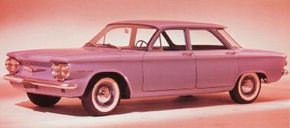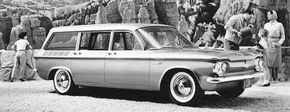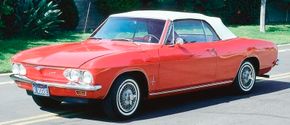Corvair was the most-controversial Chevrolet since the abortive "Copper-Cooled" model of 1923. Of course, neither was supposed to stir up trouble. Each was merely a response to a particular market situation in its day.
The problem with Corvair was a radical design that made it too costly for its original economy-car mission and too "foreign" for its target audience. Had it not opened up an entirely new market -- and almost by accident at that -- Corvair wouldn't have lasted even half of the 10 years it did hang on.
Advertisement
And there's the irony, for it was Corvair's success as a sporty compact that spawned the car that ultimately helped do it in: the Ford Mustang. A young lawyer-on-the-make named Ralph Nader did the rest.
Chevrolet's interest in a smaller companion car was evident as early as the late '40s, when it contemplated the Cadet, a prototype 2200-pound four-door sedan of conventional design begun right after World War II.
Powered by a short-stroke 133-cid version of the division's famous "Stovebolt Six," this 108-inch-wheelbase compact was intended to sell at rock-bottom prices in anticipation of a postwar recession. Instead, the market boomed, rendering the Cadet unnecessary. What's more, it would have cost as much to build as a regular Chevy, and so was deemed unprofitable at the targeted $1000 retail price. The project was thus canceled in mid-1947.
Things were far different by the late '50s. Led by Volkswagen and Renault, sales of economy imports were becoming too large to ignore, particularly once a national recession hit in mid-1957. American Motors responded with its compact 1958 American, a warmed-over '55 Nash Rambler. Studebaker chimed in with the '59 Lark, a full-size car cut down to compact size. So successful was the Lark that it temporarily halted Studebaker's ultimate slide to oblivion.
Both these independent efforts would soon have Big Three rivals. Ford was readying its Falcon and Chrysler its Valiant for model-year 1960. General Motors had peddled its so-called "captive imports," British Vauxhalls and German Opels, in 1958-59. For 1960, GM would rely on Corvair.
Initiated in 1956, the Corvair was largely the brainchild of Chevy chief engineer (and future GM president) Edward N. Cole, who became division general manager in July of that year. It was predictably a technician's car, by far the most-radical of the new Big Three compacts.
Perhaps inspired by Cole's interest in airplanes -- but more likely by the popular VW Beetle -- it was planned around a 140-cid air-cooled flat six developing 80 or 95 horsepower in initial form and -- just as uncommon -- mounted at the rear ("where an engine belongs," as Corvair ads would claim). It was a relatively complicated engine, with six separate cylinder barrels and a divided crankcase.
Yet despite a lightweight aluminum block, it ended up at 366 pounds, some 78 pounds above the target weight, a miscalculation that would have negative consequences for handling.
All-independent suspension and unit construction were equally unusual for a U.S. car. Corvair's trim 108-inch-wheelbase Y-body platform was all new, but its all-coil suspension was perhaps too basic: conventional wishbones in front, VW Beetle-style semitrailing swing axles in back. Antiroll bars were omitted to keep retail price as low as possible, but this saved only $4 a car, and GM was well aware they were needed to achieve acceptable handling with rear swing axles and the tail-heavy weight distribution.
This decision, as well as management's desire to standardize assembly, precluded more-sophisticated suspension geometry until 1962, when a Regular Production Option including stiffer springs, shorter rear-axle limit straps, and a front sway bar became available. A major suspension improvement occurred for 1964: a transverse rear camber-compensating spring.
Nevertheless, the initial Corvair suspension of 1960-63 did not create a "dangerous, ill-handling car" as later lawsuits claimed. It did oversteer to be sure, but the tail-wag tendency wasn't severe -- provided that recommended tire pressures were observed (15 psi front, 26 rear). The problem was that most owners didn't pay attention to that, and some got into trouble.
When Ralph Nader found out and wrote Unsafe at Any Speed, Corvair handling became a cause celebre that wasn't put to rest until a 1972 congressional investigation cleared the 1960-63 models. Of course, this came far too late. Corvair was already three years gone.
Advertisement


